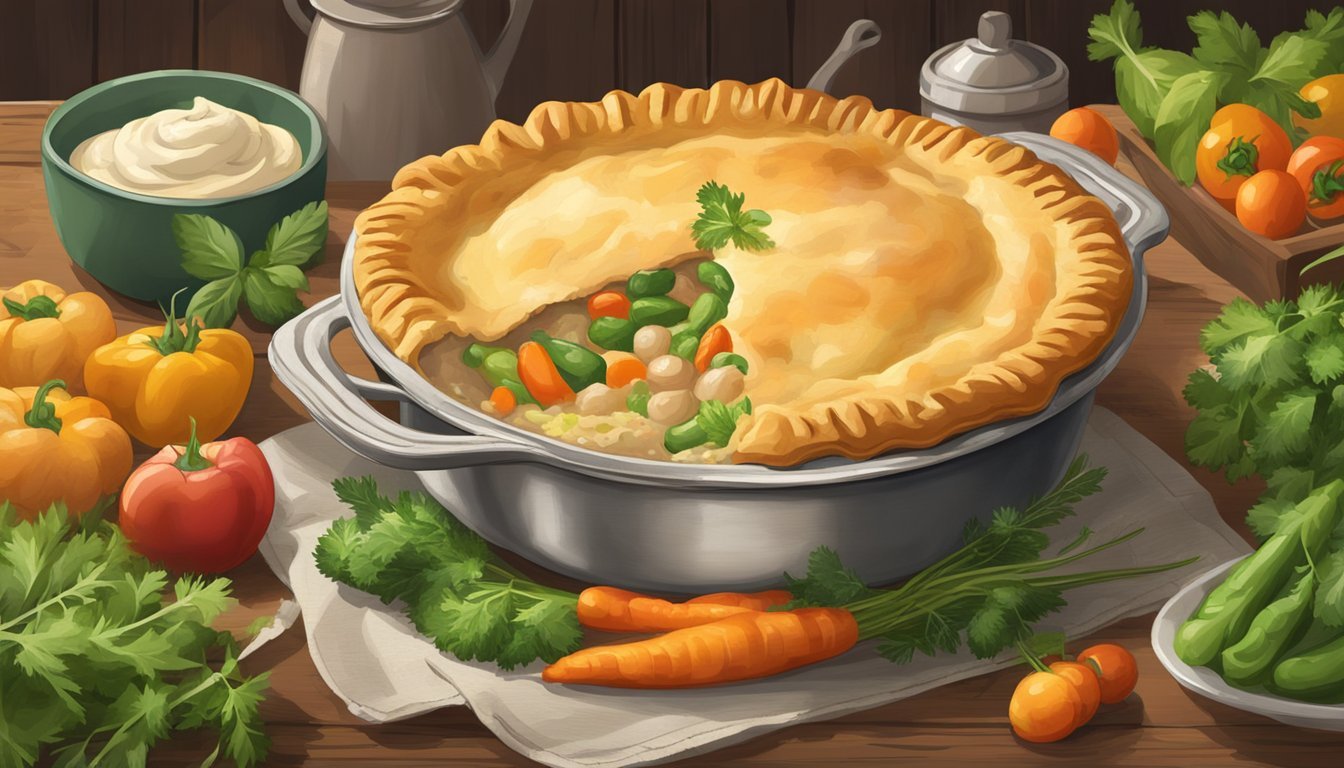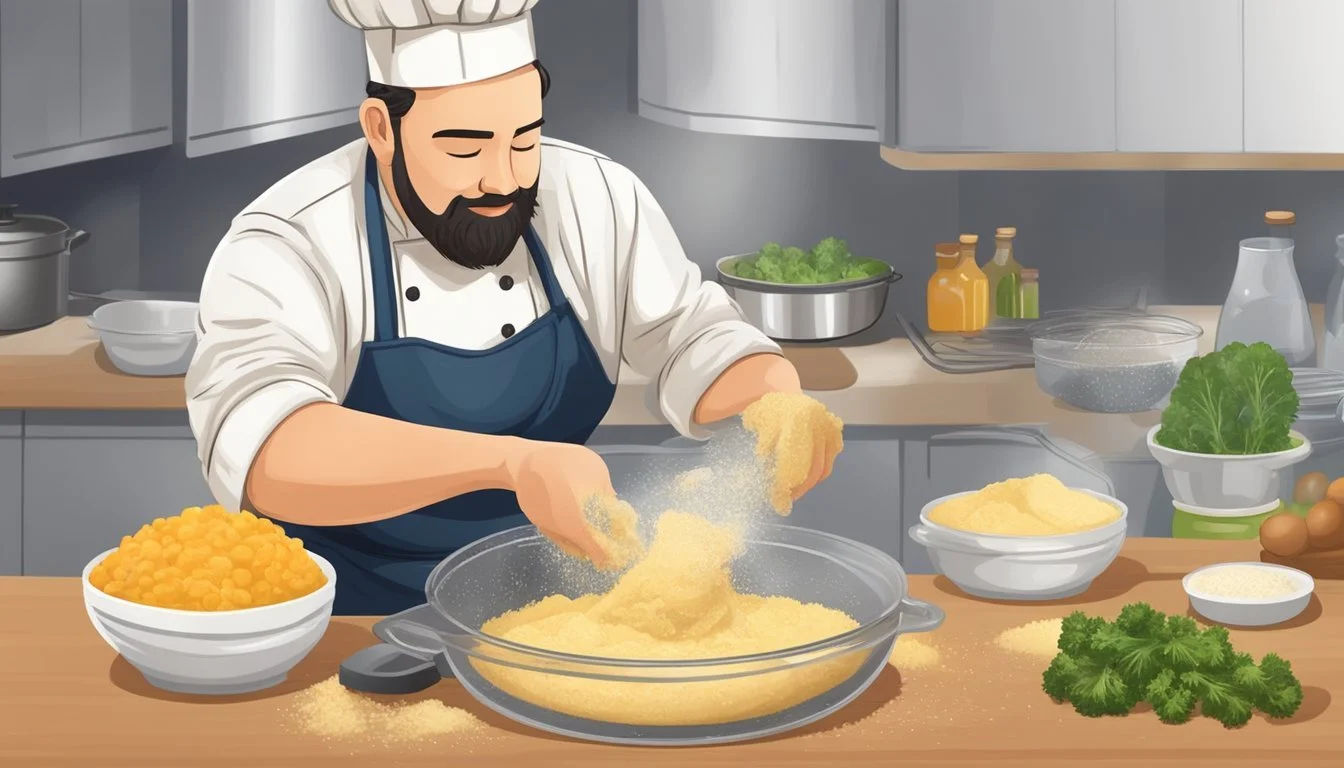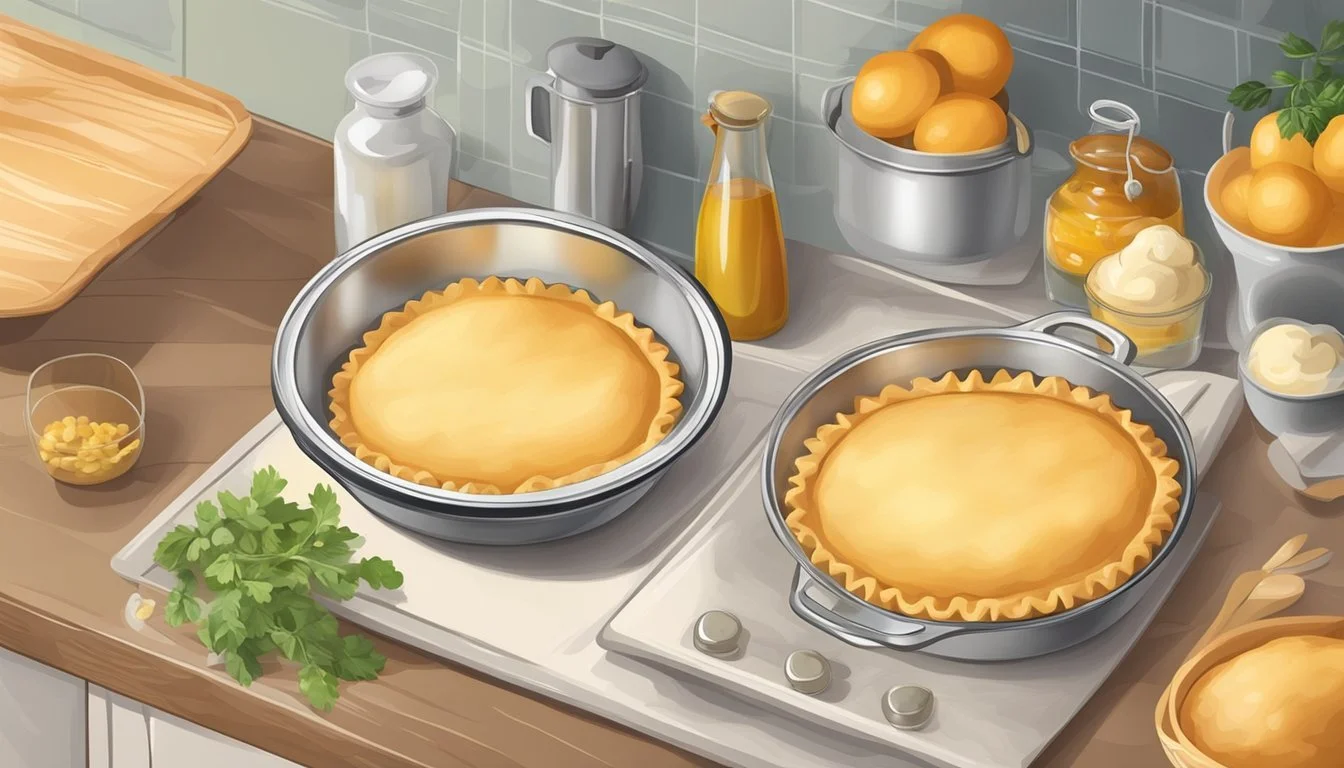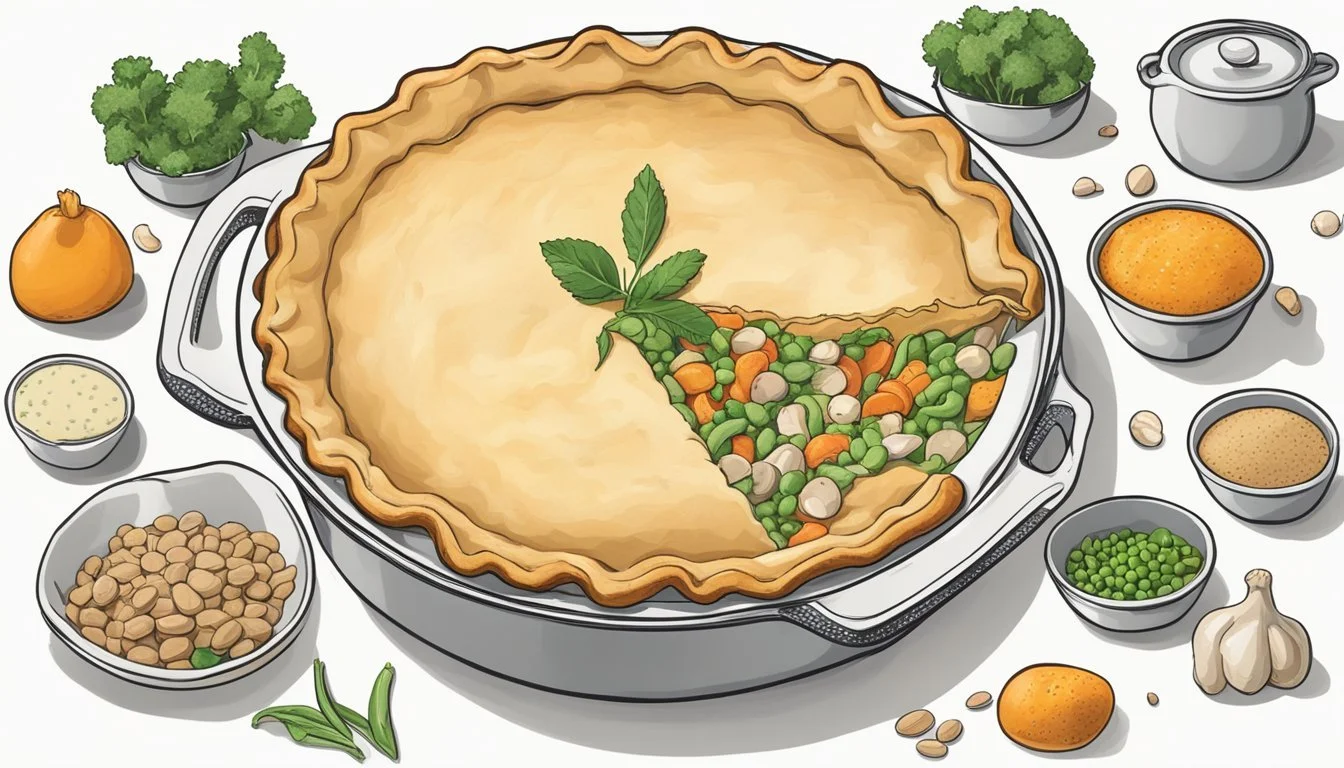Is Chicken Pot Pie Gluten-Free?
Understanding Ingredients and Options
A classic chicken pot pie (What wine goes well with chicken pot pie?) is typically not gluten-free, as it often includes a flaky pastry crust made with wheat flour, as well as thickeners in the filling that contain gluten. However, gluten-free variations are becoming increasingly popular, allowing those with celiac disease or gluten sensitivity to enjoy this comforting dish. These adaptations use alternative flour blends made from ingredients like rice, almond, or coconut flour, and thickeners such as cornstarch or arrowroot powder.
The process of creating a gluten-free chicken pot pie involves careful substitution of these traditional ingredients with gluten-free alternatives, paying special attention not only to the crust but also to the roux, which is the base of many pot pie fillings. The purpose is to replicate the delightful textures and flavors of the classic dish while ensuring that it is safe for those with dietary restrictions.
For a gluten-free chicken pot pie, the key is an approachable recipe that doesn’t compromise on taste or texture. The gluten-free versions offer a solution for maintaining the dish's hearty filling and satisfying crust while excluding any gluten-containing components. With their wide acceptance, these pies have made it possible for more people to indulge in the rich, savory flavors of a traditional chicken pot pie without the worries of gluten ingestion.
Understanding Gluten-Free Diets
In this section, we explore what gluten is and the notable benefits associated with following a gluten-free lifestyle, particularly for those with gluten sensitivity or celiac disease.
What Is Gluten?
Gluten is a group of proteins found primarily in wheat, barley, and rye. It acts as a binding agent, giving dough its elasticity and bread its chewy texture. For those following a gluten-free diet, it is important to understand that gluten is not only present in obvious foods like bread and pasta but can also be found in less obvious products such as sauces and soups.
Benefits of a Gluten-Free Lifestyle
People adopt a gluten-free lifestyle for various reasons. For individuals with celiac disease—an autoimmune disorder where gluten ingestion damages the small intestine—eliminating gluten is essential for their health. A gluten-free diet can facilitate the healing of the intestinal lining, improve nutrient absorption, and alleviate symptoms like bloating, diarrhea, and abdominal pain.
Others may choose a gluten-free diet to address non-celiac gluten sensitivity, which can cause similar symptoms to celiac disease but without the intestinal damage. A table of benefits includes:
Benefits Description Symptom Relief Reduces discomfort from gastrointestinal issues. Improved Nutritional Status Enhances nutrient absorption once the gut heals. Increased Energy Levels Many report a boost in energy after removing gluten from their diets.
The diet can also inspire more mindful food choices, leading consumers to opt for whole foods over processed options. However, individuals must ensure they're receiving all the necessary nutrients, as some gluten-free alternatives can be lower in fiber and certain vitamins. It's crucial that they check the nutritional information of gluten-free products to maintain a balanced diet.
The Basics of Chicken Pot Pie
Chicken pot pie is a savory comfort dish known for its hearty filling and flaky crust. The recipe typically combines chicken, vegetables, and a creamy sauce encased in a buttery pie crust.
Traditional Ingredients
The key components of a traditional chicken pot pie include:
Chicken: Often cooked and diced or shredded, providing the protein base for the pie.
Vegetables: A mix of peas, carrots, and sometimes potatoes for added texture and flavor.
Cream: Creates a thick and rich sauce that binds the filling together.
Chicken Broth: Enhances the flavor and adds moisture to the filling.
Butter: Used in the crust and to sauté vegetables, contributing to the pie's richness.
Pie Crust: A classic pot pie has a flaky pastry top and sometimes a bottom crust.
An egg wash may be applied to the crust before baking for a golden finish.
The Role of Flour in Pot Pies
Flour serves two main purposes in a chicken pot pie:
Thickening Agent: It's mixed with butter and broth to create a roux, which thickens the filling.
Structural Component: Flour is the primary ingredient in traditional pie crust, providing structure once baked.
In conventional recipes, wheat flour is the standard. However, for a pot pie to be gluten-free, alternative flours must be used both in the roux and the pie crust, ensuring the dish is safe for those with gluten sensitivities or celiac disease.
Gluten-Free Ingredients Overview
Creating a delicious gluten-free chicken pot pie requires careful selection of non-gluten components to ensure the classic taste remains intact. Below are the specific ingredients and alternatives needed to achieve a gluten-free version of this hearty dish.
Choosing Gluten-Free Flours
For the crust, one can use gluten-free all-purpose flour blends which typically combine rice flour, potato starch, and tapioca flour to mimic the properties of wheat flour. These blends are crucial as they provide the structure and flakiness expected in a pot pie crust. When shopping for gluten-free flour, always check the label to confirm it’s certified gluten-free to avoid cross-contamination.
Gluten-Free Dairy Alternatives
Dairy ingredients like butter and milk are common in chicken pot pie, but for those seeking dairy-free options, alternatives are available. Butter can be substituted with dairy-free margarine or even certain oils to maintain richness. For milk or cream, one can choose plant-based alternatives such as almond milk or coconut cream which offer the creaminess without the lactose, especially useful in the sauce or filling.
Bold Dairy Ingredient Gluten-Free Alternative Butter Regular Butter Dairy-Free Margarine Milk/Cream Whole Milk or Cream Almond Milk, Coconut Cream
Gluten-Free Thickening Agents
Harmonizing the sauce to achieve the right thickness in a gluten-free chicken pot pie requires using gluten-free thickeners. Cornstarch is a popular gluten-free option that can create the desired consistency without the gluten found in traditional wheat flour. Begin by mixing it with a small amount of cold broth to create a slurry before introducing it to the hot liquid to avoid clumping. This method ensures a smooth, thick sauce synonymous with a classic pot pie. Other thickeners such as arrowroot powder or xanthan gum can also be used as gluten-free alternatives.
Cooking Techniques and Prep
When creating a gluten-free chicken pot pie, the focus is on substituting traditional flours to prevent gluten content and ensuring thorough preparation of ingredients. Mastery in baking with gluten-free alternatives and careful prepping of the chicken and vegetables is essential.
Gluten-Free Baking Tips
Success in gluten-free baking hinges on the right mix of flours and adherence to precise measurements. For a flaky crust:
Choose the right gluten-free flour: A blend of rice, potato, tapioca, and sometimes xanthan gum works well as an all-purpose gluten-free flour.
Keep measurements accurate: Use a kitchen scale or leveled measuring cups for flour to prevent the dough from becoming too dense.
When baking the pie crust:
Temperature is key: Preheat the oven according to recipe specifications, typically between 400°F to 425°F.
Bake time may vary slightly from regular crusts, so one should monitor the crust's color and texture closely.
Prepping Vegetables and Chicken
Care and detail in the preparation stage ensure flavor and reduce cook time. When prepping the vegetables and chicken:
Vegetables: Chop onions, celery, and carrots into uniform pieces for even cooking. If including potatoes, dice them to a similar size.
Chicken: Opt for a high-quality protein. Either cook a fresh chicken or use precooked chicken. If cooking, ensure it's done to a safe internal temperature of 165°F before incorporation.
For the pie filling:
Sautéing vegetables in butter or oil softens them and enhances their flavors; sprinkle the gluten-free flour while sautéing to help thicken the sauce later.
Layering: Place the prepped chicken and vegetables into the pie dish before adding the gluten-free gravy to ensure an even distribution of ingredients.
Homemade vs. Store-bought Chicken Pot Pie
When considering whether to purchase a chicken pot pie from the store or making one at home, one must take into account factors like nutritional content, the presence of gluten, and the potential for customization.
Benefits of Homemade
Homemade chicken pot pie allows for complete control over the ingredients used, thereby enabling the avoidance of gluten which is crucial for those with celiac disease or gluten sensitivity. One can opt for gluten-free all-purpose flour, ensuring that the thickening agent for the filling and the crust are safe to consume. Homemade pies often boast a richer, more personalized flavor profile and the cook can select fresh, wholesome ingredients which contribute to a nutritionally balanced meal that aligns with dietary needs.
Finding Gluten-Free Options at the Store
Finding a gluten-free pot pie at the store poses more of a challenge but is not impossible. More brands now offer frozen chicken pot pies that cater to the gluten-free market. When shopping, one must diligently read labels and look for certified gluten-free seals to avoid cross-contamination risks. Although the nutritional quality of store-bought gluten-free options can vary, they offer a convenient alternative without the preparation time homemade pies require.
Assembling and Baking Your Pie
In assembling a gluten-free chicken pot pie, attention to the layering of the crust and the contents is key. Ensuring an even distribution of the filling and properly preparing the crust are crucial steps before placing the pie in the oven to achieve a golden brown, flaky crust.
Layering the Filling and Crust
To assemble the pie, one should begin by preparing a gluten-free pie crust, rolling it out to fit a pie plate with a slight overhang. The filling, a mixture of cooked chicken, vegetables, and a gluten-free thickened sauce, should be spooned into the bottom crust. For an even bake, the filling should be leveled out before topping it with the second layer of crust. The top crust can be adorned with slits to allow steam to escape, and the edges should be crimped to seal the dough.
Pie Assembly Checklist:
Prepared gluten-free pie crust
Rolled dough to fit a pie plate
Evenly spread filling
Top crust with slits
Crimped edges to seal
Baking to Perfection
Once the pie is assembled, it must be baked to perfection. Placing the pie dish on a baking sheet lined with parchment paper can prevent any spillage from dirtying the oven. An egg wash brushed on the crust will impart a beautiful golden brown finish. The pie should be baked in a preheated oven until the crust is flaky and the filling is heated through. This typically takes place at a temperature of around 375°F to 400°F for approximately 35 to 45 minutes. The pot pie is done when it's golden brown and the filling bubbles at the edges.
Baking Checklist:
Pie dish on parchment-lined baking sheet
Egg wash for a golden finish
Bake at 375°F to 400°F
Bake until golden brown and filling bubbles
Adjusting Recipes for Dietary Restrictions
When modifying a chicken pot pie to accommodate various dietary restrictions, chefs can explore dairy-free and plant-based substitutions. These adjustments require careful consideration of ingredients to maintain the dish's traditional texture and flavor.
Making Your Pot Pie Dairy-Free
To create a dairy-free pot pie, one should replace butter with oil or a dairy-free alternative like margarine. Dairy in the roux, which is critical for thickening, can be substituted with gluten-free flour and a non-dairy liquid such as almond milk or a dairy-free broth.
Substitutions:
Butter -> Dairy-free margarine/Oil
Milk/Broth -> Almond milk/Dairy-free broth
These substitutions will produce a creamy filling without the use of traditional dairy products.
Options for Vegetarian and Vegan Variants
For a vegetarian or vegan pot pie, the chicken is often replaced with hearty alternatives such as lentils, chickpeas, or a variety of vegetables like cauliflower or potatoes.
Protein Options:
Chicken -> Lentils/Chickpeas/Cauliflower/Potatoes
Instead of a buttery crust, employ a mixture of gluten-free flour and cold dairy-free margarine or oil to create a flaky vegan crust. For a complete vegan overhaul, ensure that the broth is vegetable-based and any creams or milks are from non-animal sources like coconut or soy.
Crust and Base:
Butter-based crust -> Gluten-free flour with dairy-free margarine/Oil
Animal-based broth -> Vegetable broth
Creating a dairy-free, gluten-free, or vegan pot pie allows those with dietary restrictions to enjoy this comforting dish without compromise.
Storage and Reheating Tips
Proper storage and reheating methods are essential to maintaining the quality and safety of chicken pot pie leftovers.
How to Store Leftovers
Leftover chicken pot pie should be refrigerated within two hours of cooking to ensure food safety. The pie can be covered with plastic wrap or aluminum foil, or transferred to an airtight container. To maximize freshness, store the chicken pot pie in the refrigerator for up to 3-4 days.
Best Practices for Freezing and Reheating
For long-term storage, chicken pot pie can be frozen. Wrap the pie securely with plastic wrap and then with aluminum foil to prevent freezer burn. Clearly label with the date, and store it for up to 3 months for best quality. When ready to consume, reheating should be done carefully to retain the pie's texture and flavor.
Refrigerate Pie:
Reheat in the oven at 350°F (175°C) until it's warmed throughout, approximately 20 minutes.
Cover with foil to protect the crust from overbrowning.
Frozen Pie:
Thaw in the refrigerator overnight before reheating.
Reheat as above, but increase the time as needed since it starts from a colder temperature.
Remember to always ensure the pie's internal temperature reaches 165°F for safe consumption.
Serving Suggestions and Pairings
When serving gluten-free chicken pot pie, one aims to balance the hearty and comforting nature of the dish with sides and beverages that enhance the meal without overwhelming the main course.
Sides that Complement Gluten-Free Pot Pie
The ideal side dishes for a gluten-free chicken pot pie should be light and refreshing to contrast with the rich, savory flavors of the pie. Here are specific options:
Steamed Vegetables: A mix of broccoli, carrots, and cauliflower adds color and nutrition.
Green Salad: A simple salad with a vinaigrette dressing provides a crisp texture and a tangy flavor.
Roasted Root Vegetables: Carrots, parsnips, and beets, seasoned and roasted, offer a sweet and earthy side.
Beverage Pairings
Beverages are chosen to cleanse the palate or to complement the creamy filling of the pot pie. These selections are fitting:
White Wine: A glass of Chardonnay or Sauvignon Blanc pairs well with poultry-based dishes like chicken or turkey pot pie.
Sparkling Water: A bubbly option can refresh the palate between servings. Add a slice of lemon for an extra zest.
Light Beer: A lager or pale ale can complement the comfort food aspect without overpowering the flavors.
Nutritional Information
In analyzing the nutritional aspects of chicken pot pie, one must consider the caloric content, the macronutrient distribution, and the potential presence of allergens, particularly gluten, which is a concern for individuals with celiac disease or gluten sensitivities.
Caloric Content
Chicken pot pie typically contains a significant number of calories due to its crust and creamy filling. A standard serving can range between 400 to 700 calories, depending on the size of the portion and the richness of ingredients.
Macronutrient Breakdown
Macronutrients in a chicken pot pie include carbohydrates, proteins, and fats. The crust is usually high in carbohydrates, while the filling provides protein from the chicken and fats from the butter and cream. For a gluten-free version, the crust might substitute wheat flour with other flours such as rice or almond, which also impacts the macronutrient profile.
Typical macronutrient distribution per serving:
Carbohydrates: 30-50 grams
Dietary Fiber: 2-4 grams
Sugars: 1-3 grams
Protein: 14-25 grams
Fats: 20-35 grams
Saturated Fat: 5-10 grams
Cholesterol: 30-70 milligrams
Sodium: 500-1000 milligrams
Understanding Allergens and Sensitivities
When it comes to allergens, gluten is the primary concern in traditional chicken pot pie crust. However, gluten-free alternatives often replace wheat flour with a blend of gluten-free flours such as rice, potato, or tapioca. It's crucial to always read labels for cross-contamination warnings if someone has severe allergies. Additionally, for individuals with lactose intolerance or dairy allergies, the cream and butter used can be substituted with dairy-free alternatives.
Frequently Asked Questions
When considering a gluten-free chicken pot pie, it is essential to evaluate both common concerns about its gluten content and the specific substitute ingredients necessary for a gluten-free recipe.
Addressing Common Concerns
Is traditional chicken pot pie gluten-free? No, a typical chicken pot pie contains flour in both the crust and the filling, which is made of wheat and therefore not gluten-free.
How can one ensure a chicken pot pie is gluten-free? One must use gluten-free flour for the thickening of the filling and a gluten-free pie crust to ensure that the dish is free of gluten.
Substitute Ingredients
Gluten-Free Flour: For the filling, a blend of gluten-free all-purpose flour can be used as a substitute for regular flour to thicken the sauce.
Gluten-Free Flour Types Characteristics Rice Flour Light texture Tapioca Flour Binding quality Potato Starch Thickening Xanthan Gum Stability
Gluten-Free Pie Crust: Many recipes suggest ready-made gluten-free pie crusts, or one can make it using gluten-free flour blends.
Dairy-free butter or margarine can be used to attain the flakiness required for the crust.
Eggs and milk (or non-dairy alternatives) can be included in the crust mixture to improve its texture and richness.
Conclusion
Traditional chicken pot pie is not gluten-free due to the flour used in both the filling and the crust. However, those seeking the comfort of this classic dish while adhering to a gluten-free diet have options. To prepare a gluten-free chicken pot pie, one must use gluten-free flour alternatives and ensure that all other ingredients, including the broth and pie crust, are free of gluten.
Adapting the recipe to be gluten-free requires attention to detail, especially in the choice of thickening agents and the crust. It is crucial to use gluten-free flour blends designed to mimic the texture and binding qualities of regular flour. Additionally, a homemade pie crust or a reputable store-bought gluten-free crust is central to achieving the flaky, golden-brown finish associated with a traditional pot pie.
To ensure safety and satisfaction, individuals should verify the gluten-free status of all ingredients used in the recipe. When executed properly, a gluten-free chicken pot pie can rival its classic counterpart in both taste and texture, providing a delicious and hearty meal that aligns with dietary needs.
Here is a quick checklist for a gluten-free chicken pot pie:
Crust: Use a gluten-free pie crust.
Filling: Thicken with gluten-free flour or cornstarch.
Broth: Choose a gluten-free chicken broth.
Flavorings: Confirm seasonings and any add-ins are gluten-free.
In summary, anyone can enjoy a gluten-free version of chicken pot pie with the right recipe and careful selection of ingredients, preserving the essence of this beloved comfort food.







